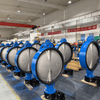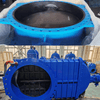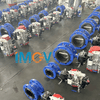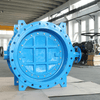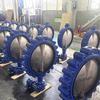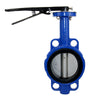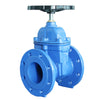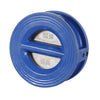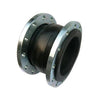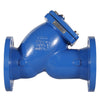Unlocking Valve Efficiency: Concentric, Double, and Triple Eccentric Butterfly Valves Explained
A butterfly valve is a type of valve in which the closing mechanism (valve disc or butterfly plate) is a disc that rotates around the valve shaft to open and close the valve. It is mainly used for cutting off and throttling in pipelines. According to structural differences, butterfly valves can be classified into three types: concentric butterfly valves, double eccentric butterfly valves, and triple eccentric butterfly valves.
Overview
The overview of concentric, double eccentric, and triple eccentric butterfly valves illustrates a progression where opening and closing the valve becomes increasingly easier, and the wear on the sealing surface decreases. By adjusting the position of the valve disc's shaft, the sealing and opening states of the butterfly valve are modified. Under the same conditions, the torque on the valve increases with each type at various degrees of opening, while the rotation angle needed for the valve disc to disengage from the seal during opening decreases progressively.
What are the structural characteristics of center butterfly valve, double eccentric butterfly valve and triple eccentric butterfly valve?
Concentric Butterfly Valve
The structural characteristic of a concentric butterfly valve is that the valve stem axis, the center of the disc, and the center of the valve body are in the same position. Generally, it is preferable to use a concentric butterfly valve whenever possible. This is because concentric butterfly valves have relatively low requirements for sealing, both in terms of structure and operation, making them standard products. To overcome squeezing and scraping and to ensure sealing performance, the seats of concentric butterfly valves are typically made of elastic materials such as rubber or PTFE, making them soft-sealed butterfly valves. This limits the usage of concentric butterfly valves in terms of temperature.
Double eccentric butterfly valve

Summary:The double eccentric design allows the valve disc to quickly disengage from the seat when opened, significantly reducing unnecessary excessive squeezing and scraping between the disc and the seat. This also reduces the opening torque, minimizes wear, and extends the life of the seat.
Triple Eccentric Butterfly Valve
Depending on the different characteristics of high- and low-temperature sealing materials, hard sealing materials are more suitable for high-temperature environments, while soft sealing materials are better suited for achieving zero leakage. To address the conflict between high temperature and zero leakage in double eccentric butterfly valves, engineers conducted in-depth research and implemented a third eccentric design. The structural feature of the triple eccentric butterfly valve is that, in addition to the double eccentric valve stem and axis, the conical axis of the disc sealing surface is further adjusted relative to the cylindrical axis of the body. Through careful design, the sealing cross-section of the disc in a triple eccentric butterfly valve changes from a circular shape to an elliptical one, thereby achieving asymmetry in the sealing surface shape. One side is parallel to the centerline of the body, while the other side is inclined to the centerline of the body. This structural optimization allows the triple eccentric butterfly valve to maintain excellent sealing performance even in high-temperature environments. Below is the design draw of the triple eccentric butterfly valve for your reference:

The first eccentricity - the eccentricity between the valve stem axis and the sealing surface

The second eccentricity - eccentricity between the valve stem axis and the valve body center

The third eccentricity - the rotation axis of the sealing surface is eccentric to the axis of the valve body channel


Drawing of triple eccentric butterfly valve
Summary: The first eccentricity of the triple eccentric butterfly valve places the valve shaft behind the disc axis, allowing the seal to fully and tightly encircle the entire valve seat.
The second eccentricity offsets the valve shaft centerline from the pipeline and valve centerline, avoiding interference during valve opening and closing.
The third eccentricity offsets the conical axis of the valve seat from the valve shaft centerline, eliminating friction during opening and closing and achieving a uniform and consistent compression seal around the entire valve seat.
The triple eccentric butterfly valve fundamentally changes the sealing method from traditional positional sealing to torsional sealing. This new sealing method no longer relies on the elastic deformation of the valve seat but entirely on the pressure of the contact surface of the valve seat to achieve the sealing effect. As a result, it solves the problem of zero leakage with metal seats. Additionally, the contact surface pressure is proportional to the medium pressure, giving the valve high-pressure and high-temperature resistance.
How to Choose Between Double Eccentric and Triple Eccentric Butterfly Valves?
Applications of Double Eccentric Butterfly Valves
Double eccentric butterfly valves have detachable seats and can be made from materials that resist corrosion, light, and aging, depending on the physical and chemical properties of different media. They are widely used in water supply and drainage, sewage, construction, air conditioning, petroleum, chemical, food, pharmaceuticals, textiles, paper making, hydropower, ships, metallurgy, and energy systems, serving as regulating and shut-off devices in fluid pipelines.
Double eccentric butterfly valves typically use PTFE (polytetrafluoroethylene) as the sealing seat material. They can also use metal sealing seats to extend their application in high-temperature areas. However, metal-seated double eccentric butterfly valves still have a positional sealing structure, where the sealing surface of the disc and seat is in line contact. Therefore, they cannot withstand high pressure. Using them in high-pressure systems can result in significant leakage. Thus, metal-seated double eccentric butterfly valves should be avoided in high-pressure or systems requiring tight shut-off.
Applications of Triple Eccentric Butterfly Valves
Triple eccentric butterfly valves, with their optimized sealing performance and high-temperature resistance, are widely used in various critical pipelines across major industrial sectors. These sectors include oil and gas extraction, offshore platforms, oil refining, petrochemicals, inorganic chemicals, energy generation, and process control in industries in China and worldwide.
Concluding Remarks
Double eccentric and triple eccentric butterfly valves differ significantly in structural design, working principles, and application scenarios. Double eccentric butterfly valves are suitable for medium to low pressure and general fluid control, while triple eccentric butterfly valves are designed for higher pressure and more demanding conditions. Choosing and applying the appropriate valve is crucial for ensuring the proper operation and safety of the system.
Due to the more complex structure and manufacturing technology of triple eccentric butterfly valves, they are more expensive than double eccentric ones. Therefore, in practical applications, selecting the most suitable valve type based on specific needs and operating conditions is an important decision.
Union Valves is a professional manufacturer of triple eccentric butterfly valves in China, offering various models and specifications. For more information, please contact us.
Related Article:
- What is a Double Eccentric Butterfly Valve?
- Triple Eccentric Butterfly Valve: Design Advantages and Working Principle
- Unlocking Valve Efficiency: Concentric, Double, and Triple Eccentric Butterfly Valves Explained
- Step-by-Step Guide to Perfect Butterfly Valve Installation

-
Posted in
Double eccentric butterfly valve, Triple Eccentric Butterfly Valve, Triple Eccentric Butterfly Valve Manufacturer

